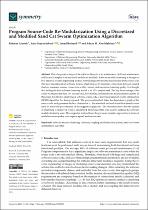 ResearchSpace
ResearchSpace
Program source-code re-modularization using a discretized and modified sand cat swarm optimization algorithm
JavaScript is disabled for your browser. Some features of this site may not work without it.
- ResearchSpace
- →
- Research Publications/Outputs
- →
- Journal Articles
- →
- View Item
| dc.contributor.author |
Arasteh, B

|
|
| dc.contributor.author |
Seyyedabbasi, A

|
|
| dc.contributor.author |
Rasheed, J

|
|
| dc.contributor.author |
Abu-Mahfouz, Adnan MI

|
|
| dc.date.accessioned | 2023-08-31T09:23:40Z | |
| dc.date.available | 2023-08-31T09:23:40Z | |
| dc.date.issued | 2022-02 | |
| dc.identifier.citation | Arasteh, B., Seyyedabbasi, A., Rasheed, J. & Abu-Mahfouz, A.M. 2022. Program source-code re-modularization using a discretized and modified sand cat swarm optimization algorithm. <i>Symmetry, 15(2).</i> http://hdl.handle.net/10204/13020 | en_ZA |
| dc.identifier.issn | 2073-8994 | |
| dc.identifier.uri | https://doi.org/10.3390/sym15020401 | |
| dc.identifier.uri | http://hdl.handle.net/10204/13020 | |
| dc.description.abstract | One of expensive stages of the software lifecycle is its maintenance. Software maintenance will be much simpler if its structural models are available. Software module clustering is thought to be a practical reverse engineering method for building software structural models from source code. The most crucial goals in software module clustering are to minimize connections between created clusters, maximize internal connections within clusters, and maximize clustering quality. It is thought that finding the best software clustering model is an NP-complete task. The key shortcomings of the earlier techniques are their low success rates, low stability, and insufficient modularization quality. In this paper, for effective clustering of software source code, a discretized sand cat swarm optimization (SCSO) algorithm has been proposed. The proposed method takes the dependency graph of the source code and generates the best clusters for it. Ten standard and real-world benchmarks were used to assess the performance of the suggested approach. The outcomes show that the quality of clustering is improved when a discretized SCSO algorithm was used to address the software module clustering issue. The suggested method beats the previous heuristic approaches in terms of modularization quality, convergence speed, and success rate. | en_US |
| dc.format | Fulltext | en_US |
| dc.language.iso | en | en_US |
| dc.relation.uri | https://www.mdpi.com/2073-8994/15/2/401 | en_US |
| dc.rights | Attribution-NonCommercial-NoDerivs 3.0 United States | * |
| dc.rights.uri | http://creativecommons.org/licenses/by-nc-nd/3.0/us/ | * |
| dc.source | Symmetry, 15(2) | en_US |
| dc.subject | Cohesion | en_US |
| dc.subject | Modularization quality | en_US |
| dc.subject | Sand cat swarm optimization algorithm | en_US |
| dc.subject | Software module clustering | en_US |
| dc.title | Program source-code re-modularization using a discretized and modified sand cat swarm optimization algorithm | en_US |
| dc.type | Article | en_US |
| dc.description.pages | 28pp | en_US |
| dc.description.note | © 2023 by the authors. Licensee MDPI, Basel, Switzerland. This article is an open access article distributed under the terms and conditions of the Creative Commons Attribution (CC BY) license (https://creativecommons.org/licenses/by/4.0/). | en_US |
| dc.description.cluster | Next Generation Enterprises & Institutions | en_US |
| dc.description.impactarea | EDT4IR Management | en_US |
| dc.identifier.apacitation | Arasteh, B., Seyyedabbasi, A., Rasheed, J., & Abu-Mahfouz, A. M. (2022). Program source-code re-modularization using a discretized and modified sand cat swarm optimization algorithm. <i>Symmetry, 15(2)</i>, http://hdl.handle.net/10204/13020 | en_ZA |
| dc.identifier.chicagocitation | Arasteh, B, A Seyyedabbasi, J Rasheed, and Adnan MI Abu-Mahfouz "Program source-code re-modularization using a discretized and modified sand cat swarm optimization algorithm." <i>Symmetry, 15(2)</i> (2022) http://hdl.handle.net/10204/13020 | en_ZA |
| dc.identifier.vancouvercitation | Arasteh B, Seyyedabbasi A, Rasheed J, Abu-Mahfouz AM. Program source-code re-modularization using a discretized and modified sand cat swarm optimization algorithm. Symmetry, 15(2). 2022; http://hdl.handle.net/10204/13020. | en_ZA |
| dc.identifier.ris | TY - Article AU - Arasteh, B AU - Seyyedabbasi, A AU - Rasheed, J AU - Abu-Mahfouz, Adnan MI AB - One of expensive stages of the software lifecycle is its maintenance. Software maintenance will be much simpler if its structural models are available. Software module clustering is thought to be a practical reverse engineering method for building software structural models from source code. The most crucial goals in software module clustering are to minimize connections between created clusters, maximize internal connections within clusters, and maximize clustering quality. It is thought that finding the best software clustering model is an NP-complete task. The key shortcomings of the earlier techniques are their low success rates, low stability, and insufficient modularization quality. In this paper, for effective clustering of software source code, a discretized sand cat swarm optimization (SCSO) algorithm has been proposed. The proposed method takes the dependency graph of the source code and generates the best clusters for it. Ten standard and real-world benchmarks were used to assess the performance of the suggested approach. The outcomes show that the quality of clustering is improved when a discretized SCSO algorithm was used to address the software module clustering issue. The suggested method beats the previous heuristic approaches in terms of modularization quality, convergence speed, and success rate. DA - 2022-02 DB - ResearchSpace DP - CSIR J1 - Symmetry, 15(2) KW - Cohesion KW - Modularization quality KW - Sand cat swarm optimization algorithm KW - Software module clustering LK - https://researchspace.csir.co.za PY - 2022 SM - 2073-8994 T1 - Program source-code re-modularization using a discretized and modified sand cat swarm optimization algorithm TI - Program source-code re-modularization using a discretized and modified sand cat swarm optimization algorithm UR - http://hdl.handle.net/10204/13020 ER - | en_ZA |
| dc.identifier.worklist | 26864 | en_US |
Files in this item
The following license files are associated with this item:






